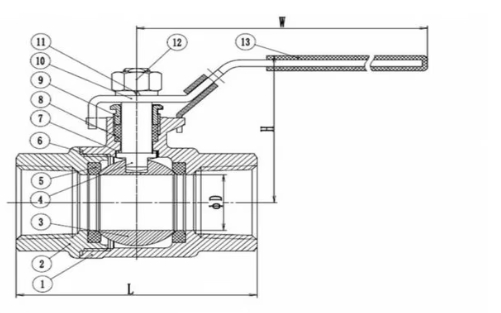
Clearly identify the diameter of your company's pipelines to determine the appropriate diameter and connection method for electric ball valves.
Based on pipeline requirements, first determine some common parameters of electric ball valves, such as discharge capacity, allowable flow resistance, and valve seat hole diameter. Incorrect selection of these parameters can greatly reduce the effectiveness of flow control by electric ball valves.
Select suitable materials based on the working temperature of the pipelines. Additionally, consider the working pressure of the pipelines.
Furthermore, it is advisable not to rush into product selection. Prioritize understanding the currently available electric ball valve products and their performance. A good approach is to request product catalogs and specifications from multiple electric ball valve manufacturers, compare them, and choose the product with the best cost-effectiveness.
In addition to paying attention to pipeline parameters, special attention should be given to the environmental conditions in which electric valves operate. Since the electric devices in electric valves are electrical machinery and equipment, their operational status is greatly affected by the operating environment.
In general, special attention should be paid when using electric ball valves in the following environments:
Indoor installations or outdoor applications with protective measures.
Outdoor installations exposed to wind, sand, rain, sunlight, etc.
Environments with flammable or explosive gases or dust.
Tropical or desert environments.
Pipeline medium temperatures exceeding 450°C.
Ambient temperatures below -20°C.
Susceptibility to flooding or immersion in water.
Environments containing radioactive substances (nuclear power plants and radioactive material test facilities).
On ships or dockyards (environments with salt spray, mold, and humidity).
Environments with severe vibrations or prone to fires.
For electric ball valves in the above environments, the structure, materials, and protection methods of the electric devices may vary. Therefore, appropriate valve electric device should be selected based on the aforementioned operational environments.
Functional Requirements of Electric Ball Valves
For electric ball valves, their control functions are accomplished by electric devices based on engineering control requirements. The purpose of using electric ball valves is to achieve non-manual electrical control or computer control of valve opening, closing, and adjustment. The application of electric devices is no longer just about saving manpower. Due to significant differences in functionality and quality among products from different manufacturers, the selection of electric devices and the associated valves are equally important for engineering projects.
Electrical Control of Electric Ball Valves
As industrialization continues to advance, the application and control requirements of electric valves are increasing. Therefore, the design of electric valves in terms of electrical control is constantly evolving. With the increasing demands for usage, new and diverse electrical control methods will continue to emerge alongside the widespread use of computers. When deliberating on overall control of electric valves, attention should be paid to selecting the appropriate control method. For example, whether to use centralized control, single-device control, linkage with other equipment, sequential control, or computer-based sequential control depends on the engineering requirements, and the control principles vary accordingly. The electrical control principles provided in the valve electric device manufacturer's samples are only standard principles; therefore, the application department should communicate technical requirements clearly with the electric device supplier to ensure understanding of the technical requirements.
